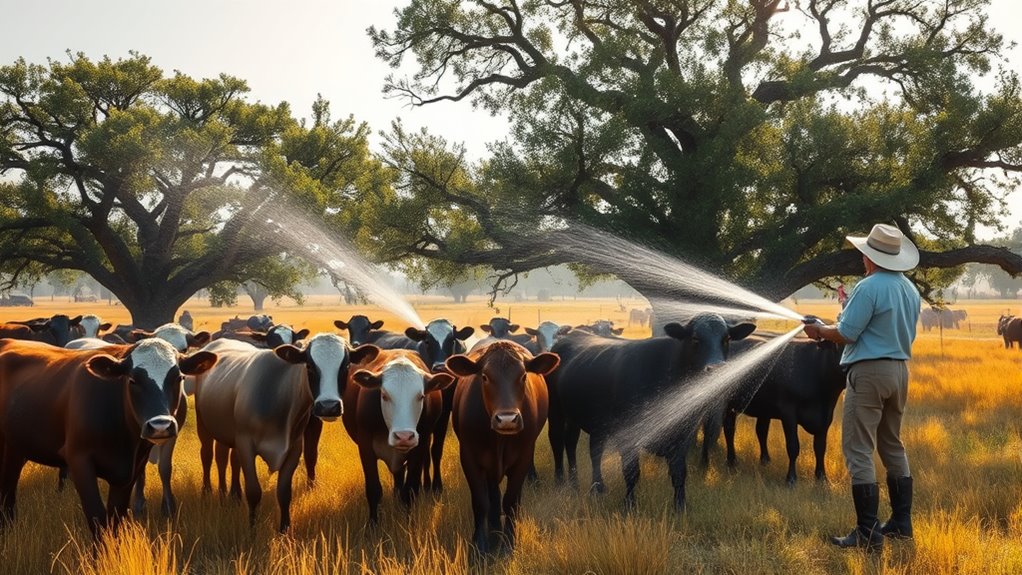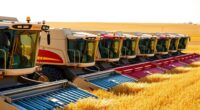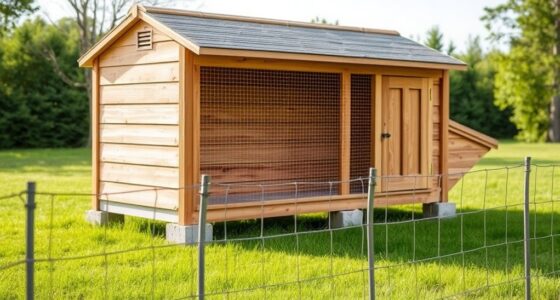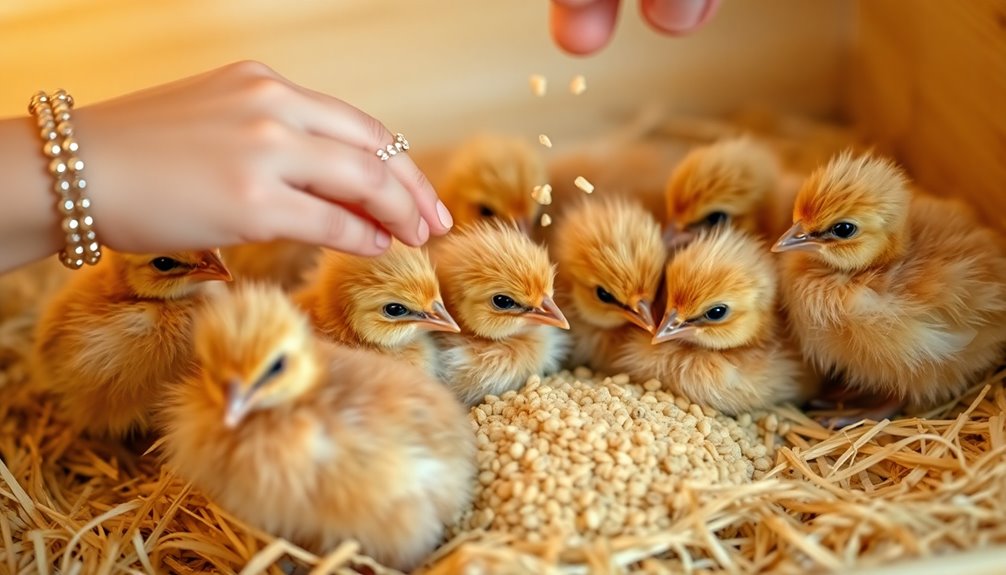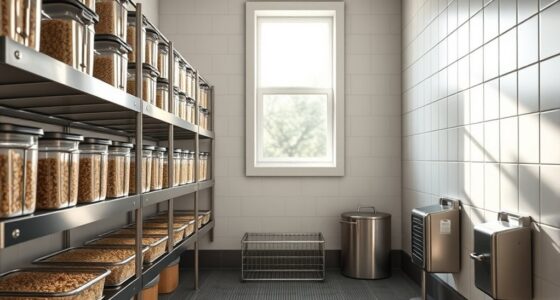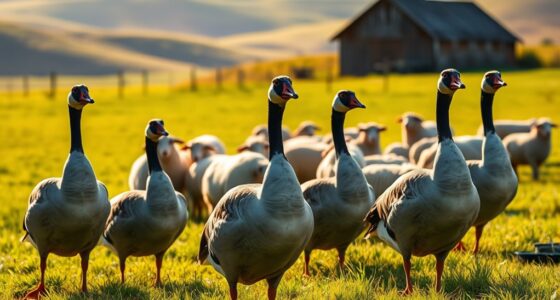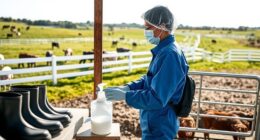During late-summer heat waves, guarantee your cattle have plenty of shade and fresh water to prevent heat stress. Use fans, misters, and sprinklers to promote cooling, and adjust feeding schedules to cooler parts of the day. Monitor your livestock closely for signs of distress like rapid breathing or lethargy. Proper pasture management and emergency cooling measures can make a big difference. To keep your animals safe and comfortable, discover more effective strategies below.
Key Takeaways
- Provide ample shaded areas and strategically position shelters to reduce heat exposure.
- Ensure continuous access to clean, cool water, adding ice or chilled water during peak heat.
- Optimize ventilation with well-maintained fans and airflow systems to remove heat and humidity.
- Use misters or sprinklers carefully to promote evaporative cooling without causing stress.
- Monitor livestock closely for signs of heat stress and adjust management practices promptly.
Recognizing Signs of Heat Stress in Livestock
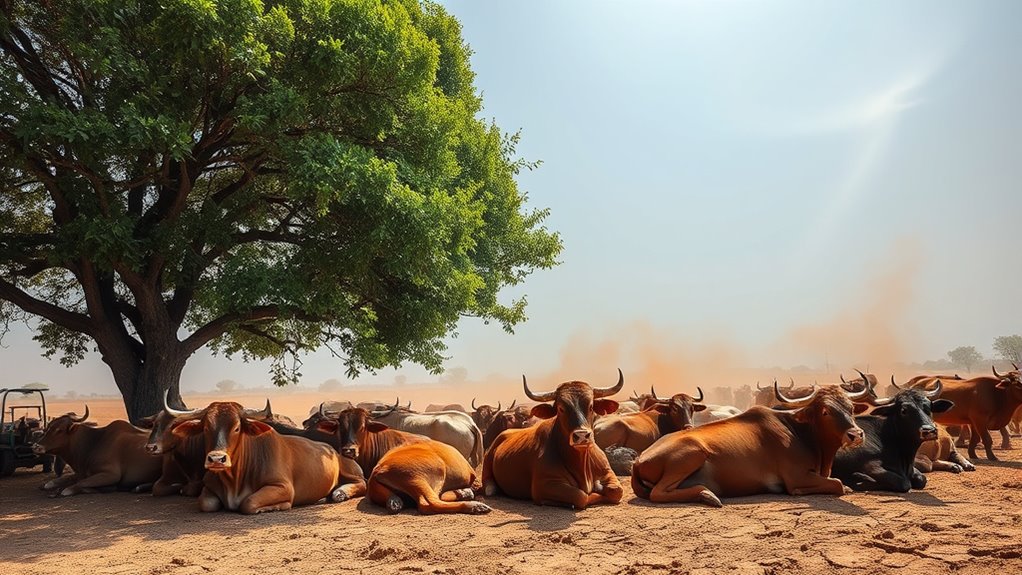
During hot summer days, livestock are vulnerable to heat stress, which can quickly affect their health and productivity. As a caretaker, you need to recognize the early signs to prevent serious health issues. Watch for excessive panting or labored breathing, which indicate your animals are struggling to cool down. Look for increased drooling or salivation, often linked to discomfort. Restlessness and seeking shade or water are also common signs. You might notice decreased appetite or reluctance to move, signaling stress. In severe cases, animals may become lethargic, stumble, or display a glazed, sunken-eyed appearance. Additionally, ensuring proper headphone connectivity, such as Bluetooth pairing or wired connections, can help you stay alert and communicate effectively while monitoring your livestock. Promptly identifying these symptoms allows you to take necessary measures quickly, minimizing health risks and maintaining your livestock’s well-being during hot weather.
Providing Adequate Shade and Shelter Options

Providing adequate shade and shelter is essential for protecting livestock from the intense heat of summer. Shade reduces heat stress by offering a cooler environment, encouraging animals to rest and conserve energy. You should install sturdy, well-ventilated structures that block direct sunlight and allow airflow. Trees, shade cloths, or constructed shelters work well, but make certain they are positioned to provide maximum coverage during the hottest parts of the day. Shelter should also protect animals from wind, rain, and sudden weather changes. Regularly inspect these structures for damage or wear, and maintain them to guarantee they remain effective. Incorporating artistic innovations in shelter design can also improve animal comfort by promoting better airflow and shade distribution. By offering effective shade and shelter, you help livestock stay comfortable, reduce heat-related health issues, and improve overall productivity during hot weather.
Ensuring Access to Fresh, Cool Water
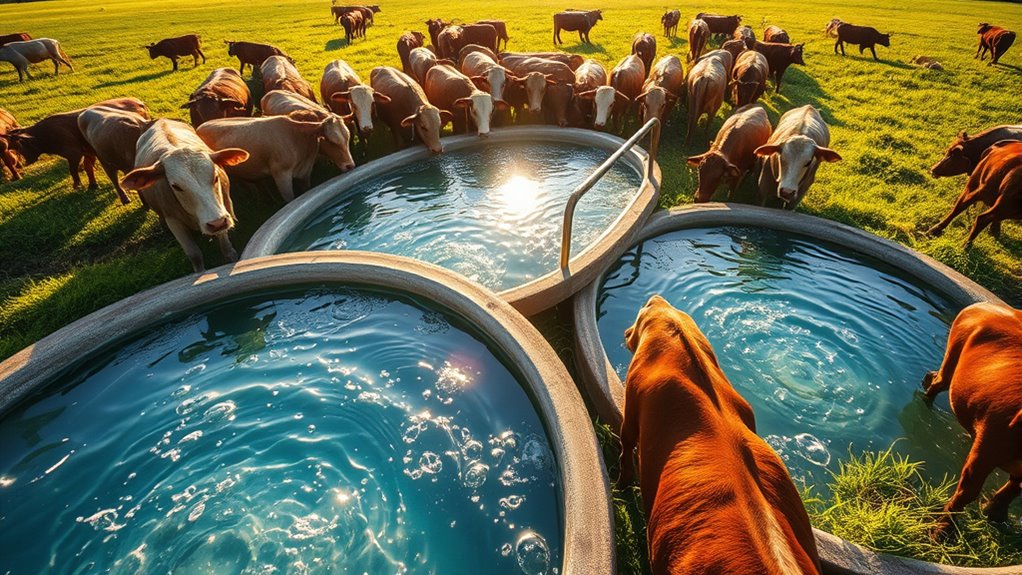
Ensuring your livestock have access to fresh, cool water is essential for their health and productivity during hot weather. When temperatures rise, cattle and other livestock lose water quickly through sweating and respiration. If they don’t drink enough, they risk dehydration, heat stress, and reduced feed intake. Provide multiple water sources throughout your facilities to prevent crowding and ensure easy access. Regularly clean and refresh the water to prevent bacteria buildup and keep it tasting fresh. Consider adding ice or chilled water during peak heat times to help lower their core temperature. Monitor water consumption daily, especially during heatwaves, and adjust supply as needed. Adequate hydration supports digestion, cooling, and overall well-being, helping your livestock stay healthy and productive despite the heat. Modern water systems often include filtering and circulation features that maintain water quality and promote better health.
Implementing Effective Ventilation and Airflow Systems
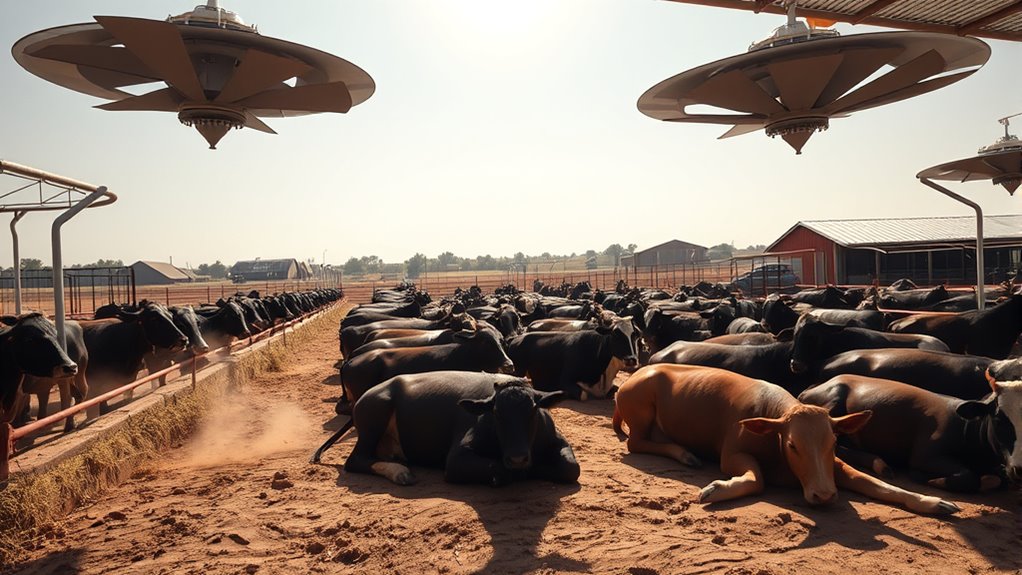
To keep your livestock comfortable during hot weather, you need to focus on proper ventilation design and airflow optimization. You can improve system efficiency by selecting the right fans and vents, and by adjusting their placement for maximum effectiveness. Regular maintenance guarantees your ventilation system runs smoothly and continues to provide the cooling your animals need. Incorporating performance upgrades such as specialized fans or adjustable vents can further enhance airflow and cooling efficiency during peak heat periods.
Proper Ventilation Design
Effective ventilation is essential for maintaining comfortable and healthy conditions in livestock facilities during hot summer months. Proper ventilation design ensures fresh air circulates, removing heat, humidity, and odors that can stress your animals. To achieve this, focus on strategic placement of vents, fans, and exhaust systems that promote continuous airflow. Avoid dead spots where stale air can linger, and ensure air enters and exits efficiently. Well-designed ventilation can prevent heat stress, reduce illness, and improve overall productivity. When planning, consider the size of your facility, airflow patterns, and local climate conditions. A thoughtfully designed system makes your livestock feel cooler, healthier, and more comfortable, ultimately supporting their well-being and your farm’s success.
- You can save animals from heat stress, ensuring their comfort and health.
- You create a safer environment, reducing illness and mortality.
- You foster peace of mind knowing your livestock are protected during extreme heat.
Airflow Optimization Techniques
Optimizing airflow in your livestock facility is essential for maintaining a cool and healthy environment during hot weather. You can achieve this by strategically positioning fans to promote consistent air movement across the entire space. Use exhaust fans to remove warm, stale air from the building and ensure fresh air enters through intake vents or windows. Adjust fan speeds based on temperature and humidity levels to prevent drafts that could stress animals. Incorporate airflow barriers or curtains to direct air where it’s needed most, avoiding dead zones. Regularly monitor airflow patterns with an anemometer or airflow sensors, making adjustments as necessary. Proper airflow management helps dissipate heat, reduce humidity, and improve overall comfort for your livestock. Additionally, implementing AI-driven safety measures can optimize ventilation systems further by predicting heat stress conditions and automating fan responses.
Maintaining System Efficiency
Maintaining system efficiency requires careful implementation of ventilation and airflow systems that operate reliably under hot weather conditions. You need to verify these systems are properly maintained, calibrated, and monitored to prevent breakdowns when heat stress peaks. When your ventilation works seamlessly, your livestock stay cooler, healthier, and more productive, even during intense heatwaves. Proper airflow reduces humidity and removes harmful gases, creating a safer environment. Don’t let system failures jeopardize your animals’ well-being. Regular inspections and timely upgrades keep your system resilient. Ensuring your ventilation system’s calibration is accurate maximizes airflow effectiveness during extreme temperatures.
- Feel the relief of knowing your animals are protected from heat stress
- Experience the confidence that comes with reliable ventilation on scorching days
- Witness healthier, more comfortable livestock thriving despite the heat
Utilizing Misters and Sprinklers for Cooling

Using misters and sprinklers can effectively lower livestock temperatures when applied correctly. You need to make certain the spray is even and consistent to avoid water wastage and discomfort. Proper application helps prevent water stress and keeps animals comfortable during hot days. Additionally, understanding the science of evaporation can help optimize cooling strategies by maximizing heat removal through water vaporization.
Effective Spray Application
Effective spray application plays a crucial role in cooling livestock during hot weather, as it helps lower body temperatures quickly and efficiently. Proper timing and coverage ensure your animals stay comfortable and reduce heat stress. Use gentle, evenly distributed sprays to promote cooling without causing discomfort. Focus on areas like the neck, shoulders, and flanks, where heat tends to build up. Monitor the animals’ responses and adjust spray intensity as needed. Consistent application can improve their well-being and productivity. Incorporating good lighting can enhance visibility during spray application, ensuring thorough coverage and safety. Feel the relief in your animals’ eyes as they cool down and become more relaxed. Witness their energy and appetite bounce back after effective spraying. Experience the peace of mind knowing you’re actively preventing heat-related health issues.
Preventing Water Stress
While spraying helps cool livestock quickly, relying solely on water can lead to stress and dehydration if not managed properly. To prevent water stress, guarantee your livestock always has access to fresh, clean water. Misters and sprinklers should be used to supplement water intake, not replace it. Avoid overusing water systems, which can cause excessive sweating and electrolyte loss. Monitor the animals closely for signs of dehydration, such as lethargy or dry gums. Incorporate water stations in shaded areas to encourage drinking and reduce heat stress. Adjust watering schedules based on temperature and humidity levels, and ensure water sources are clean and replenished regularly. Proper water management helps keep your livestock healthy, hydrated, and better able to withstand the heat. Understanding livestock vulnerabilities is essential for implementing effective cooling strategies during hot weather.
Adjusting Feeding Schedules During Peak Heat
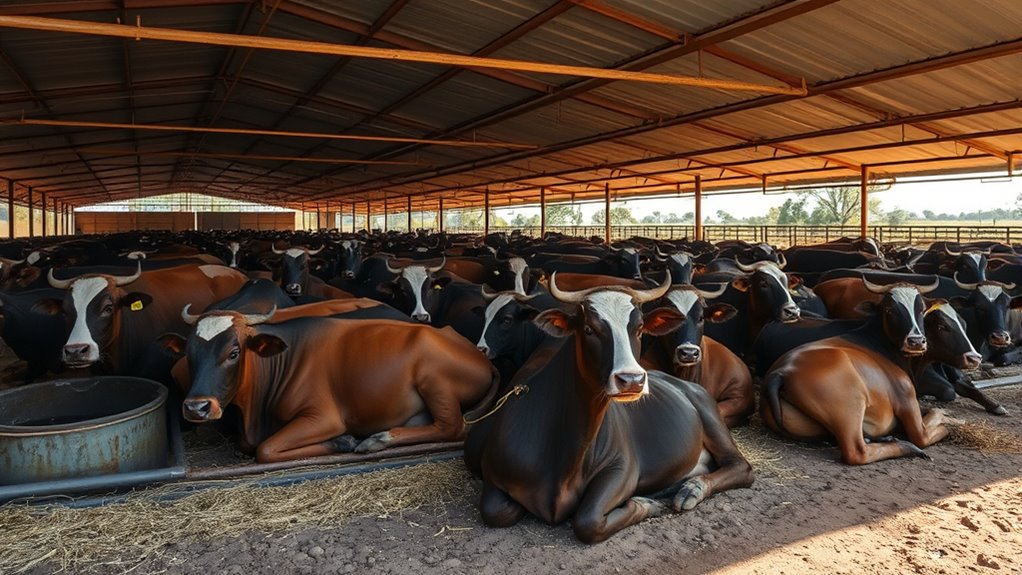
During peak heat, adjusting feeding schedules can help livestock better cope with high temperatures. By offering feed during cooler parts of the day, you reduce the risk of heat stress and improve digestion. Early morning or late evening feeding can keep animals more comfortable and promote better nutrient absorption. Additionally, aligning feeding times with seasonal temperature patterns can optimize livestock health and productivity. Consider these strategies to protect your livestock: – *Feed during dawn and dusk to minimize heat exposure and boost intake.* – *Reduce feed amounts during the hottest hours to prevent digestive overload and overheating.* – *Provide fresh, cool water alongside adjusted feed times to support hydration and overall well-being.* Implementing these changes shows your commitment to animal health and can considerably decrease heat-related stress and production losses. Your proactive steps make a real difference in keeping your livestock healthy during intense summer heat.
Enhancing Pasture Management for Better Heat Dissipation
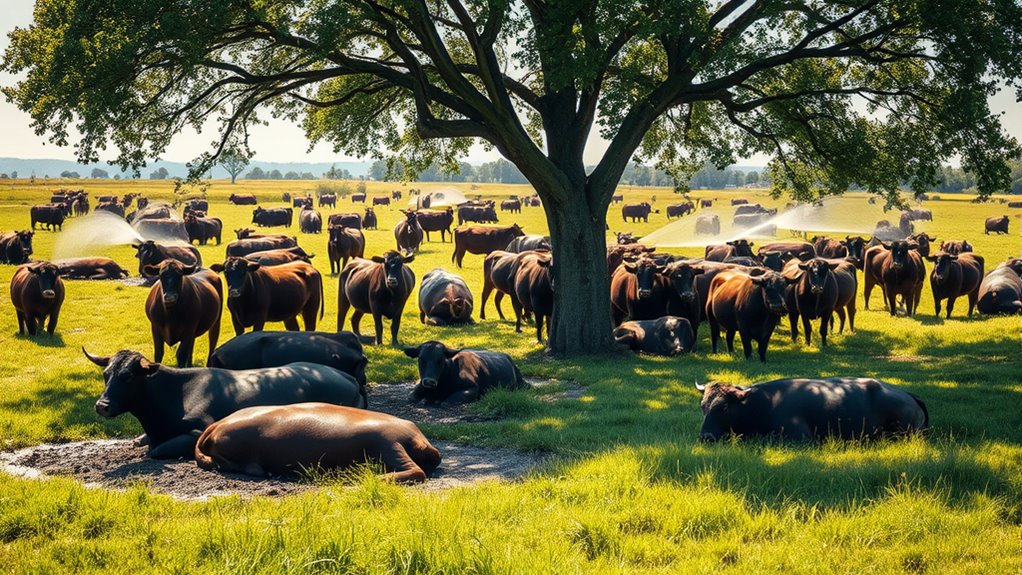
Enhancing pasture management is essential for helping livestock stay cool and healthy when temperatures soar. Proper pasture practices improve airflow, shade, and soil moisture, all critical for heat dissipation. Rotate grazing areas to prevent overgrazing, which reduces ground cover and increases heat retention. Incorporate shade trees strategically to provide relief and promote evaporative cooling. Use the table below to plan pasture elements that maximize heat dissipation:
| Pasture Feature | Benefit | Implementation Tip |
|---|---|---|
| Shade Trees | Reduce ground temperature | Plant in high-traffic areas |
| Sufficient Grass | Evaporative cooling | Maintain optimal forage levels |
| Water Sources | Increase humidity and cooling | Ensure accessibility and cleanliness |
| Soil Management | Improves water retention | Avoid compaction and promote aeration |
| Grazing Rotation | Prevents overuse, maintains cover | Schedule grazing to balance pasture health |
This approach helps create a cooler environment, promoting livestock health during heat waves.
Monitoring Livestock Health During Heat Events

Effective monitoring of livestock health is crucial when heat waves strike, ensuring early detection of signs indicating heat stress or illness. You need to stay vigilant, observing cattle closely for changes in behavior or appearance. Look for rapid breathing, drooping ears, and reduced feed intake—clear signals something’s wrong. Regularly check for dehydration signs like sunken eyes or sticky mucous membranes. Keep detailed records of temperature, respiration rates, and behavior shifts to identify patterns quickly.
- Feel the heartbreak of seeing animals struggle silently, risking their lives.
- Experience relief when you catch early warning signs and act swiftly.
- Know that timely intervention can save animals from severe heat-related illnesses.
Monitoring isn’t just about data; it’s about protecting your livestock’s well-being during critical moments.
Planning for Emergency Cooling Measures and Long-term Solutions

Preparing for emergency cooling and implementing long-term solutions are essential steps in safeguarding your livestock from extreme heat. Start by developing a detailed plan that includes quick-response actions, such as providing additional shade, misting systems, or portable fans. Guarantee you have backup water sources and transportation options ready in case of power outages or equipment failure. For long-term solutions, invest in permanent shade structures, improved ventilation systems, and water management strategies that promote cooling. Regularly evaluate and update your plans based on weather forecasts and livestock health data. Train your staff to recognize early signs of heat stress and respond swiftly. Planning ahead minimizes risks, protects your animals’ well-being, and helps maintain productivity during heat waves.
Frequently Asked Questions
What Are the Economic Impacts of Heat Stress on Livestock Productivity?
Heat stress reduces livestock productivity, leading to lower milk yields, slower growth rates, and decreased reproductive success, which hit your profits hard. You’ll face increased veterinary costs and the need for cooling systems, raising expenses. Additionally, heat stress can cause mortality and reduce overall herd health, resulting in significant economic losses. Managing these impacts is essential to maintaining productivity and profitability during late-summer heat waves.
How Can Technology Assist in Monitoring Heat Stress Remotely?
You can use advanced technology like wearable sensors and remote monitoring systems to track livestock’s crucial signs and environmental conditions in real-time. These tools automatically alert you to signs of heat stress, enabling swift action. Drones and thermal imaging cameras can also monitor large herds from a distance, helping you identify animals in distress quickly. This proactive approach helps maintain animal welfare and productivity during hot weather.
Are There Specific Breeds More Resistant to Heat Stress?
Yes, certain breeds are more resistant to heat stress. For example, Brahman and Brahman-cross cattle have higher heat tolerance due to their loose skin, large ears, and increased sweat glands. You should consider these breeds if you’re in hot climates, as they better withstand high temperatures and reduce stress. Choosing heat-tolerant breeds can improve your livestock’s health, productivity, and overall well-being during late-summer heat waves.
What Are Cost-Effective Cooling Solutions for Small-Scale Farmers?
Imagine saving money while keeping your livestock cool—that’s possible with cost-effective solutions. You can hang shade structures, install simple fans, or use water sprinklers, which are affordable and effective. These methods cool animals naturally and reduce heat stress without breaking the bank. By focusing on these practical options, you guarantee your livestock stay healthy, productive, and comfortable during scorching summer days, all while staying within your budget.
How Does Humidity Affect Livestock Heat Stress Management?
Humidity substantially impacts livestock heat stress management because high humidity reduces animals’ ability to cool themselves through evaporation. When the air is moist, sweating and panting become less effective, increasing the risk of heat stress. To manage this, you should provide shade, improve ventilation, and make sure access to clean, cool water. Using fans or misters can also help lower humidity around the animals, aiding their natural cooling processes.
Conclusion
As the summer sun sets behind the horizon, remember that your livestock’s well-being is the heartbeat of your farm’s future. By providing shade, water, and fresh air, you become the shelter in their storm, the cool breeze that eases their burden. With attentive care, you nurture resilience amid the heat’s challenge, ensuring your animals thrive like a steady stream through the dryest days—your commitment lighting the way to a healthier, stronger herd.

